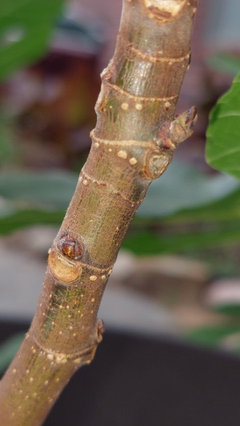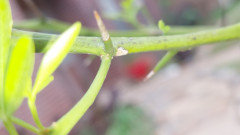Can you truly get rid of scales
My plants have what I believe are scales. It seems I have lost several plants to them over the last few years. They seems to infest a plant, sometimes I get them under control temporarily and they seem to move onto a new plants or sometimes they just kill that plant. They truly suck the life out of them.
Is there any way to really get rid of these once and for all. I have tried soap and water, I have bought insectides. I have two right now I am trying to save. Maybe I should just throw the plants out. That's so hard, as they were big beautiful plants at one time.
TIA,
Comments (70)
meyermike_1micha
12 years agoI am so sorry Ann!
I feel your pain. I have gotten so sick of worrying about the plants that provide great hiding places for these critters that I have almost just about rid all of the ones that these critters hide well in.
Now I only grow plants that will expose any pest I can get my hands on and kill. No more hiding places. I just threw away 3 Dracaena plants, very lovely mind you, because I found a mealy on one and they are all very close in proximity to each other. Taking no chances here.
Seems like my plant collection will continue to diminish if I should find any on my Hoya plants too:-(.
I can't wait to get them outdoors and start mass treating them.Mike
rhizo_1 (North AL) zone 7
12 years agoMike, don't forget that you can keep a spray bottle on hand, filled with one part rubbing alcohol to three parts water (or so) to mist that hoya with. Even if you don't see any mealies, mites, or scale. The mist gets into the nooks and crannies where it would be so easy to miss an infestation getting ready to explode.
Related Professionals
Derry Landscape Architects & Landscape Designers · Elgin Landscape Contractors · Dickinson Landscape Contractors · East Patchogue Landscape Contractors · Estelle Landscape Contractors · Hayward Landscape Contractors · Las Vegas Landscape Contractors · Middletown Landscape Contractors · South Farmingdale Landscape Contractors · Tustin Landscape Contractors · Waltham Landscape Contractors · Woodburn Landscape Contractors · New Carrollton Landscape Contractors · East Hanover Interior Designers & Decorators · Westbury Interior Designers & Decoratorsbirdsnblooms
12 years agoAnn..I posted on this thread, 4 years ago, lol. To this day, I firmly believe Fish Emulsion rids Scale. By spraying, a lovely Olive tree and two Citrus are well and alive.
The only Negative regarding Fish Emulsion is its odor. But, if you want to keep a plant, a couple days of a fishy smell is worth it. Or, if you have access to a garden, porch or patio, spraying your Staghorn Fern in one of the areas, 'outdoors, you wouldn't notice at all,' you'd hardly get a whiff.
Mike, sorry about your Dracaenas. Those darn Mealy are difficult, if not impossible ridding. For some reason, quite a few people have been dealing with Mealy this year..Wonder why??
Rhizo, you're so right. Keeping a bottle of RA or any organic insecticide, is a great preventative. Toni
meyermike_1micha
12 years agoThank you Rhizzo!
I shall have to do this if I ever see just one appear on my Hoya. What kind of spray bottle should I use? It seems that any spray bottle I use, the spray mechanism inside deteriorates with time.
Can one store this mix or should you make it fresh everytime?I have another question if you don't mind?
What can I use on jades and other succulents? I have been told by a few to use the alcohol and water spray, but then others have told me that the mix can burn the leaves, along with oil products.....I am not sure.
Your advice and opinion would greatly mean a lot to me and be appreciated.Thank you:-)
Hey Toni.
You are so right about using FE. Works like a charm as you told me it would years ago.
I will 4ever be indebted to you for that one:-)
I hate mealy and luckily have never had an issue with them except on those plants with many leaf and joint crevices.Mike
rhizo_1 (North AL) zone 7
12 years agoWhat do you mean, "if I mind"....silly boy, lol.
I use inexpensive plastic spray bottles, and not ones that have been recycled from a previous use. Yes, you can mix your alcohol solution up ahead of time and keep the bottle by the plants you may want to mist occasionally. I would not even wait until you see mealies, mites, or other pests. Sometimes you can't see the nymphs, they are so small.
I've used the alcohol on jade for years. No soap, no oil, but alcohol is fine.
Don't mist it on plants that are going to sit in the direct outside sun, it needs to dry first. There is also no need to rinse the solution off. Just like on your skin, it evaporates. No fuzzy plants or those with very fragile foliage, at least not without a good leaf test.
birdsnblooms
12 years agoMike, you're too funny.... :)
BTW, if you're looking for plastic, spray bottles, Home Depot is having a sale. 1.00 per bottle.
Don't waste your $ on Plant spray bottles in the green house.
Check the asile that sells cleaning or household products. Bottles sold for plants are 3.99. They're all the same, except when labeled for plants, the price increases. I bought 5 new bottles! lol. 5.00 plus tax, compared to 20.00 plus tax.
Hope you're well, ToniGreenJeans9
12 years agoWhat about temporarily moving the plant outside? Since scales seem to be a problem for indoor plants only, would that get rid of them?
birdsnblooms
12 years agoGreenjeans...taking an infested plant outside isn't going to solve anything..in fact, by ignoring the problem, Scale will eventually suck the life from a plant/s.
Also, Scale live outdoors. They can attack outdoor/garden plants as well as indoor.
Do you have a plant w/Scale? Toni
rhizo_1 (North AL) zone 7
12 years agoToni is so right. Scale insects can be found on many different kinds of trees, shrubs, vines, and groundcovers.
tapla (mid-Michigan, USDA z5b-6a)
12 years agoUsually, there is a significant reduction in the effects of a scale infestation, actually, any infestation of insects with sucking/rasping mouth parts, when the plant is moved outdoors; this, for two reasons.
First, there will be a significant increase in the number of predatory insects helping to keep the scale in check. Second, the biocompounds plants employ as a defence mechanism against insect predation is a byproduct of the plant's metabolism. In most cases, plants respond to being moved outdoors with significant increases in their metabolism, and thus, in their ability to defend themselves against insects.
I wouldn't expect the condition to be completely cured, but I also wouldn't consider it wishful thinking to expect a significant reduction in both the effect of the predation and in the tenacity of the bugly little thugs in a move outdoors. .... and of course, Toni is right in that scale are persistent pests both indoors and out.
Al
GreenJeans9
12 years agoThanks everyone for your responses. I have a ficus tree that unfortunately has a nasty case of scales and based on previous exchanges in this thread am leaning towards hand-applied rubbing alcohol. I hadn't heard of outdoor scale infestations, so thought that could be an easy fix, but it sounds like that is an unreliable approach.
MichiganMikeKaz
11 years agoScales have drawn me to become a member. The evil of scales is that you don't know you have them until it's almost too late. By the time the "crawlers" (which I've never seen crawl) have matured to the point of secreting sticky goo all over, chances are, you are fighting an uphill battle. One thing not noted here but should be obvious - trim away the worst leaves and branches before applying whatever remedy works for you. I think all have merit, but the trick is frequency and coverage. What mystifies me is how an indoor office plant with no new friends can suddenly get scale after being isolated for over a year. Are these crawlers floating around in the air?? Also, make sure you sanitize watering cans when dealing with infected plants - don't let the nozzle touch any part of a suspect plant. Any new success stories?
rhizo_1 (North AL) zone 7
11 years agoHi MichiganMike! Welcome to GardenWeb. Just to make you feel at home right away....I'm going to disagree with part of your statement, lol.
I honestly and truly don't think that these insects sneak up on us and seemingly overnight explode in population. We just aren't observant enough and/or knowledgeable enough to catch an infestation at an early onset.
The office plant mystery really isn't a mystery at all. The scale came in when the plant did! Maybe it was just a couple of adults, well hidden under a leaf. Scale can reproduce without mating, so over months or years of office life, they can reach a population that finally becomes noticeable.
What might have prevented the outbreak is occasional treaments with a horticultural oil of some kind or with mistings of alcohol.
MichiganMikeKaz
11 years agoWell, that's a welcome! :P I realize the exponential component of their reproduction, but it would seem to me that after a full year of complete isolation, I would have found these a long time ago--one little sticky spot, some sign. I dusted this anthurium from time to time and nothing noted, then in the matter of two weeks, an explosion! One thing I now see are small webs, but not from spider mites...do the "premies" generate any kind of output (or is my company's office in need of a filter cleaning? Lol). I have successfully removed scale from rubber plant, paradise plant, zamio culcas zamiifolia, and ficus because I always catch it early and that was by an alcohol scrubbing. I dread doing this manual process again so I am trying the alcohol spray. Ah, the things nightmares are made of!
cactusmcharris, interior BC Z4/5
11 years agoI can tell you what worked for me with succulent plants - these included columnar, glaucous cacti (no injury to their beautiful blue colour), haworthias, Echinocactus, and the like:
Spray them with Windex or Formula 409 when the plant's out of the sun and spray heavily - let sit 10 minutes or so, then blast with hosed water. It will knock them right off with no plant damage and no use of insecticides.
Horticultural Help
11 years agoScale insects are quite treatable if your treatment of choice is extremely thorough. Although pesticides do have some toxic residual effect on any insects pests that are not directly contacted by the spray, the non-pesticidal remedies depend entirely on direct contact with each insect in every stage.
That means that Q-Tipping and hand wiping will always miss some of the critters hiding in crevices. The result is that the few that are missed will reproduce and come back again en masse in a few months. However a thorough spraying that leaves ALL leaf and stems dripping wet and gets into the crevices has an excellent chance of permanent success.
Also keep in mind that scale insects that have been properly sprayed may remain in place even though they are dead. Sometimes folks assume they are alive and the treatment has not been effective. Therefore, wiping all of the visible scales AFTER the thorough spraying is a good idea.
Alcohol diluted with water and with a squirt of liquid dish soap has excellent coverage and spreading capacity so it works quite well. For plants that have deep crevices where the leaves attach to the stems, I recommend a product called Brand X, availabe only online. It contains silicon which has superior penetrating capacity. It is a leaf cleaner, not a pesticide.
~Will
marguerite_gw Zone 9a
11 years agoI got rid of scale on outdoor plants in a rather drastic fashion. I completely de-leaved them and then manually wiped all the trunks and branches with baby wipes every day for about a week, and that did the trick. It was a case of three small potted shrubs and an orange tree, and they survived. I have been lucky enough not to have scale on houseplants so far, fingers crossed.
amber_m
11 years agook so ive got a question, im currently battling scales, actually i dont know if battling is the right word, ive only seen maybe 8 over the last week and all on 4 new plants that i just ordered, i can not seperate them from the rest of my plants so ive been treating ALL of my plants with a alcohol/water/dish sope mixture that ive been spraying on once a day. i have two hoya compactas that ive been manually spreading some of the leaves that have curled tight together and spraying into them... my question is that if im going and doing this once a day (which might seem drastic but my husband is on the verge of chucking all of my beautiful plants because of the work "pest") and the mixture is getting on the soil the plant is potted in do you think this is going to hurt my plants? all most all of the plants are either hoyas, spider plants or christmas cactus... i was kind of misting the soil on purpous because i know some of the pests will live on/in the soil, but im hoping its not too much to kill the plant... do you think i should flush the soil after doing this or would that be too much dampness for them to take? here are some pics of how my plants are kept together... i know that scales need to walk/crawl to get to other plants so im hoping that even though they are so close together the fact that they are hanging might help?
{{gwi:82097}}
Source: Uploaded by user via Amber on Pinterest
Horticultural Help
11 years agoHi Amber,
Scale insects don't spread among plants as readily as is commonly believed. Concentrate on treating the 4 new plants that have scale. Once they are treated properly you need not be concerned about their spreading to other plants.
A limited amount of soap/alcohol runoff into the soil will not harm your plants. However, if you are spraying daily, then the cumulative effect may not be so good. If you are truly thorough in your initial spraying, then follow-up spraying should not be necessary. Don't overreact to your husbands threats.
Scale insects do not live in the soil so there is no need to spray the soil.
~Will
jessaka
11 years agoI have had 3 of my wonderful plants die of scale. I just tossed out a 6 year old Boston fern, and tomorrow I will toss out a spider plant.
My question is this? Is the scale still in the house? I ask because it was 6 months ago that one of my ferns had it and I tossed it and now finally the Boston fern.
I want to buy another Boston fern but not until I can make sure it will not get scale from the other. I also plan on scrubbing the pot because it is a pot I love, and I can bleach it if necessary.
I moved two of my other plants into another room and maybe they are okay.
emceeNYcap
11 years agoI have been losing plants to scale for a couple of years now. I fought it on my peace lily, which was in my family for decades, before I finally gave up. That included hosing, soaps, alcohol, repotting. I did not know to try spraying with fish emulsion, which I have but do not use as a spray.
I have gotten to the point of just getting rid of a plant when I find scale, because it never seems to go away. Months will go by, and then another plant will be infested. Even in the kitchen where there are no plants left, I will bring in cut herbs and they will have little white bugs on them in a few days.
I don't know if it initially came from a new plant (I was mailed bamboo), or if they were on plants I inherited years earlier, and took a while to be noticeable. They could have been in this apartment when I moved in almost 3 years ago. I am afraid they are in my wood furniture now, and that even if I move they will come with me.tapla (mid-Michigan, USDA z5b-6a)
11 years agoImidicloprid is an over-the-counter insecticide that is effective against scale. It is available in a vehicle designed to be sprinkled on the soil, a liquid soil drench that usually has no mixing directions for indoor applications, and in preparations designed to be used as a spray, but the actual spraying needs to be done outdoors and the application allowed to dry on the plant before bringing the plant indoors. I find the later (the spray) to be most effective for houseplants, particularly for trees and other plants with woody stems. I use Bayer Advanced 3-In-1 Insect, Disease & Mite Control, which is an excellent product when scale infestations occur, and can be used against mites. The product also includes a systemic fungicide that is very effective as a prophylactic and a fixitive against most fungal infections, should you encounter one. All in all, it's a good multiple purpose product to have at your disposal for indoor or outdoor containerized plants, but remember to follow directions and particularly that the spraying is to be undertaken outdoors only.
Also effective against scale are horticultural oils that have the word(s) light - summer - or all-season in their names. When using the oils, COMPLETE coverage is required or it's likely the infestation will be recurrent. Neem oil is also very effective against scale, but requires persistence. Often, being faithful to 4-6 applications at 2-3 week intervals are required to rid the plant of reproducing adults. Home remedies like alcohol preparations and fish emulsion solutions may have some knockdown effect on predators in the crawler stage, but leave adults under their protective shells largely unaffected, leaving eradication by these methods unlikely.
Al
Filly4ever
11 years agoJust joined since I have battled scale for too many years & need some good, hopefully natural, remedies other than dumping the poor thing in the trash. Have contemplated that many times and still am.
At any rate, it took reading thru the great comments and suggestions here for me to connect the fact that the "flocking" which is all I can call it, that has covered my fax machine, printer and scanner for some time now wasn't due to their being located close to an open window, so much as they were getting rained on by excrement from the scale infested fern hanging above them. I didn't realize this until it was mentioned here since I've tried to keep the scale minimized with alcohol/cotton ball treatments not noting anything sticky on the leaves, but I gather it was still enough to drizzle a sticky coating that gathered dust....hence the flocking effect. Seriously doubt it would have a commercial market so it's been done in.
As for cleanup, I found using a product called De-Solv-It by Orange-Sol worked beautifully to quickly and without scrubbing or harm to the equipment clean the gunk off. I used a Scrubbie, both sides depending on where the film was, but I think a regular sponge would be fine. De-Sol-It works wonders on stubborn stains, but I don't know what it would do to furniture. It might be wise to try an inconspicuous spot first or dilute it a bit to be safe. It used to be sold everywhere, but I can only get it now in my local Ace Hardware store. Not sure why the decrease in distribution. Anyway scale poo doesn't stand a chance against it.
As for weakening plants, fluoride can do a lot of damage to plants. Without going into all the terrible injurious things fluoride does overall to everything, among the worst is that fluoride causes disruption and inhibition of quite a number of enzymes vital to the function of all living things. I have to believe it is a likely reason our plants don't have the resistance anymore to pests like scale, with some plants being more susceptible than others. Here's a link to give you a better idea of what I'm talking about.
http://plantsarethestrangestpeople.blogspot.com/2009/02/fluoride-what-it-is-and-how-its-spelled.html
I'm not implying this is the only source of the problem, I simply know from having studied human and animal susceptibility and the insidious and varied damage from fluoride, that plants must be affected far more than we expect them to be.Thanks for all the good advice.
NorthernLala
11 years agoJust joined :) I finally gave up today, and threw out 8 plants because of scale. Some of them have been with me for many, many years. I never had a problem with scale until maybe 3 years ago- that's when some gift plants entered my home. :(
I'm a horticulturist. Believe me, I have tried it all but it always managed to come back, so today I finally decided it was time to let go and give up.
Hate the scale!!orchidislander
10 years agoI have loved reading all these different ideas and experiences. I'm trying to get rid of scale on one of my houseplants and also an orchid. It was recommended to me to get the petro-chemical insecticide, and I thought I would do it, but I just can't give money in that direction. So today I concocted my own mix in a 16 oz. spray bottle:
1 part water
1 part rubbing alcohol (70%)
a squirt of biodegradable dish soap
10 drops eucalyptus essential oil
10 drops thyme essential oil
5 drops citronella essential oil.My idea is that the alcohol will hopefully kill the eggs and ones in the bump stage, and the essential oils will hopefully kill or deter the crawlers. If I keep at it for the next few weeks, I hope to get them in all stages. I think also that plants that are struggling for nourishment in some form are more susceptible to pests, so I'm also addressing that.
petrushka (7b)
10 years agorhizo!
you got me! i was getting ready to cut-n-paste...great vodka solution! i'll need it soon :) as post-battle recovery.
over the years i've been loosing plants to scale continuously, more then for any other reason. so when i see scale i go ballistic.
the only thing that worked for me was systemic with imidacloprid: i use bonide indoor systemic for safety , so it's not as strong as outdoor formulation. and since it takes up to a week for the plant to absorb it - i also manually remove the nursery-leaves (those with most dew /scale on them); pick off the adult scale that i can see + spray heavily with insecticide soap and repeat spraying at 5 day intervals - up to 3 times or until i cannot see any visual signs of infestation.
that said, new solutions are always welcome.
i will spray houseplants that are coming in this year with FE at weekly intervals for sev weeks before they come in (that seems to be a good preventive solution) - that is in addition to my systemic preventive for all coming in 2 weeks prior; and insecticidal soap on last day.
i have sev questions to posters too.
cactusmcharris:
do you use regular original WINDEX with ammonia or the one without?
mrmothernature:
how do you use Brand X - by itself as 'coating solution' that deters infestation/chokes scale? or instead of dish soap ?
as far as light horti oil goes,
it burns young leaves on a lot of my indoor/outdoor plants, even in mid summer when they are hardened - so though it's s effective for mite scurge i refrain from using it. it completely killed my 2 crotons; destroyed leaves completely on hydrangeas and damaged ivy leaves, especially young, but also pitted the old leaves quite unsightly. so i am scared of using it.connie_in_oklahoma
9 years agoI have problems with scale on my orchids. I use a tobacco tea. It doesn't hurt the orchids and the scale hates it. I repeat it every 10 days until I don't see scale anymore. I do have to repeat every so often during the year. I just put a wad of tobacco in about 4 cups of water and nuke it for a while and then I let it sit for a while until it is cool.
goddenfents
9 years agothanks for all the helpful hints. one cure that i have found to be effective, and that i did not see in reading through, is that for smaller plants, complete submersion in water for 24 hours, including both the plant and the pot of dirt, drowned all scale in all stages, never to return. the plants were fine with the treatment.
i also found that here in the northeast, when putting larger houseplants outdoors in the summer, some insect seems to be very effective in cleaning all the scale off the plants, and the plants thrive, giving them a better chance in the fall if the scale return when the plants come back indoors. good luck!anotherstephanie
9 years agoI want to second what goddenfents said; submerging a plant for 24 hours has been the only thing that's made any of my plants scale-free. (Note: I've also tried neem, alcohol, and soap-- but not fish emulsion, nor Cepacol, Brand X, nor any sort of alcohol/soap mix).
Sigh. I have two gorgeous scheffleras submerged in buckets now. Fingers crossed that it works again.
PAE54
9 years agoThe water method for getting rid of scale has my interest! Are you under the impression that this can work for all plants? I have many beloved and very old hoya plants (indoor) that are clearly suffering.
I am going to take them out of their containers, submerge in their entirety for 24 hours, and then replant in fresh pots, albeit that Goddenfent indicated pot and all. Are you only using water for this purpose?
Yes! I shall try this on one plant, and then pray I don't lose it!
anotherstephanie
9 years agoHi! I don't know much about hoyas, but I think they could take immersion, looking at their photos. I do want to report back on the latest two plants I treated by immersion. Both plants are doing beautifully, but I have also seen signs that both plants still had a few scale left on them. I've been keeping an eye on the leaves and cleaning them, and in the last week I've definitely found one or two that did not appear dead. So, either they got re-contaminated, or immersion doesn't work quite as well as I thought. :( However, you'll get MOST of the scale off, if you're prepared to be a bit vigilant afterwards. Good luck!
PAE54
9 years agoThank you! I can deal with a few issues, and might employ an alcohol treatment afterwards. I'll post after I begin the process.
Best to you!
summersunlight
9 years agoMaybe the immersion technique would work better if you soaked the plant not just in plain water but in a solution of neem oil, detergent and water? I think you may be on to something with the soaking treatment since years ago I was once able to seemingly eradicate scale from a Sansevieria by soaking it in a solution of water with systemic pesticide mixed in.
I suspect it also improves the odds of success if you use a completely new pot, soil, and move the plant to a new location in your house since I suspect the scale insects can probably live on furniture or windowsills for a while waiting to reinfest after you've treated the plant.
Leona N
8 years agolast modified: 8 years agoI now realize I'm in a losing battle with a majesty palm and scale.
As I wave the white flag and prepare to toss it out....how do I clean my hardwood floor? :(
Sticky residue. Beautiful hardwood. House is only a year old, and hubby is pissed!
Gretchen Collin
8 years agolast modified: 8 years agoHas anyone tried cutting the plant back to its base and repoting it? I have an infected queenland umbrella tree that is over 30 years old now and I am having no luck getting rid of the scale. Does anyone know if this helps?
tapla (mid-Michigan, USDA z5b-6a)
8 years agoThe two treatments that work well on scale are horticultural oils that say "summer", "all-season" or "perfect" on the label or systemic insecticides like imidicloprid, which is available in several products made by Bayer. Bayer 3-in-1 for insect, disease, and mite control has a miticide + systemic fungicide and insecticide (imidicloprid). It works very well against scale. Often one treatment is enough, though 3 are suggested. It's approved for use on houseplants but any spraying must be done outdoors.
Immersion is actually a very ineffective remedy. Insects don't have lungs and breath through openings on their abdomen, Often, they can store enough air in bubbles around these openings to keep them alive for days under water. Some ants can survive submerged for up to a week.
AlLisa
8 years agoTo clean hard surfaces, you could try Zep Big Orange - the
commercial grade, if you know anyone who can get it for you (try a vinyl sign
place). The one that HD sells isn't as effective, so try to get the commercial
grade. I have friends with a vinyl sign place, so I get it from them. Use
Windex or any detergent to clean up the oiliness left by the Big Orange.Dave Ebert
8 years agoNeem oil has worked beautifully for me on a cycad (Dioon) that was obviously suffering from scale. It's doing great now.
petrushka (7b)
6 years agothe only sure method is systemic - in soil application. but since it takes about a week for the plant to absorb systemic into tissues - it is usually recommended to spray initially too (neem is good or rubbing alcohol solution, but some plants do not like either/or) - so as to prevent scale from spreading to neighboring plants.
there is indoor houseplant formulation with imidacloprid (weaker then for outdoors),
no spraying, just mix with top inch of soil. i've used it for years.
https://www.amazon.com/Bonide-Product-951-Systemic-Control/dp/B000BX1HKI
petrushka (7b)
6 years agoyou can clean scale residue with rubbing alcohol too - works instantly, but it depends what kind of wood finish you have. windex will work too. just spray the paper towel, not wood. can try fantastic too. even soapy paper towel will take it off - but wood does not like water, so rubbing alcohol is preferred in this case.
tapla (mid-Michigan, USDA z5b-6a)
6 years agoAbout pests with rasping/sucking mouth parts. I have 4.95 lbs of Marathon, which is a granular product that makes the insecticide imidacloprid systemically available via the root pathway - essentially the same product linked to a couple of posts upthread. I won't use it again because of the negative impact on root health I've witnessed when using the granular vehicle.
A better and faster acting product (still employs imidacloprid as the active insecticide) is Bayer Advanced 3-In-1 Insect, Disease, and Mite Control. Used topically (outdoors) in the early morning and left in the shade for a day, it's absorbed into the plant much faster than soil drenches and granular products that use the root pathway. It also contains a very effective systemic fungicide (tebuconazole) that works efficaciously on most varieties of fungaluglies. If you're concerned about bees, don't apply to blooming plants.
There is nothing wrong (from the plant's perspective) with using imidacloprid that's delivered via the root pathway; however, I've found the 1.47% liquid soil drench used for trees and shrubs, diluted to 1 teaspoon in a qt/liter of water to be far superior to any granular product I've used, for reasons mentioned.
Al
petrushka (7b)
6 years agospraying outside is just not possible for everybody.
me in particular, as i only have access to a small balcony (packed with plants, needless to say) and i am sensitive to any kind of 'spray inhalation' - hence no systemic sprays for me - to each his/her own as they say.
i have used the bonide product for maybe 8 years running on many many kinds of plants that can be regarded as houseplants (mostly tropicals) and they all are doing fine and better then fine actually.
i just occasionally get scale from putting plants on the balcony.
tapla (mid-Michigan, USDA z5b-6a)
6 years agoOf course I was addressing those w/o the type of limitations you are dealing with. I think it goes w/o saying that when an individual is limited by circumstance, it has no bearing on the product's ability to perform. We can probably assume that those forced to deal with circumstantial limitations will adapt as best they can, but an overview of other individual's experience should help them decide what's in their own best interest.
Al
petrushka (7b)
6 years agoagreed :). and i was just sharing my solution - as perhaps some other people are in the same boat.
but despite my limitations i keep something like 150 houseplants healthy and going strong for a decade (and some much longer) ..and enjoy doing it too (well, most of the time ;).. :)...
AND combine it with extensive travel (so leave them unattended - as i grow everything on self-watering wicks). that's why in-ground systemic granules are a must for me - they continue working for 8 weeks after application. so in case the scale hits when i'm not there - it won't be with disastrous consequences (happened a couple of times BEFORE i discovered bonide systemic, when i was on vacation).
so it might assure or even inspire :)? some other people that it can be done ;) .
Kim Shannon
last monthFor some reason, I can't seem to type on this webpage well. So, typing this in notes and hopefully adding as comment. I was given some plants about a year ago. I am relatively new to gardening but had managed to create a pretty yard from what used to be a weed bed. In any case, I took in my father, who has dementia this past year. So, I have been very busy and preoccupied. My Confederate Rose was losing leaves for months before I realized that I might have a scale issue. I have treated twice with Bonide Orchard Spray, and it helped. Although, I didn't treat as often as I should have. When we had the short freeze this winter, I think that was the straw that broke my Confederate Rose's back. I sm hoping to save my yard. Please wish me luck.
Esther-B, Zone 7a
27 days agoI had a dracena which had the characteristsic white blobs appear on its leaves. And it spread to another couple of my succulents. I applied Bonide Systemic insecticide for houseplants granules in the soil of ALL my houseplants, just to make sure. And it worked! The blobs all disappeared.
tapla (mid-Michigan, USDA z5b-6a)
27 days agoThe active ingredient in Bonide Systemic Granules is imidacloprid. If it is being applied or mixed into a highly aerated fast-draining medium, it will reduce air porosity and inhibit drainage. That might not make much difference if you're using a commercially prepared medium comprised of a very high % of fine materials, but it would definitely be something that should be taken into consideration for plants that don't like wet feet. It's not the insecticidal properties that cause the problem; rather it's the vehicle (the granules) that cause the problem. That issue can be sidestepped altogether by using a soil drench containing imidacloprid. See more about that in one of my posts above, the one with the embedded link "Soil drench".
I have a nearly full 5 lb container of Marathon granular insecticide (today's cost about $100) that anyone who would like it can have for the price of shipping (See Here), which contains 1.0% imidacloprid as opposed to the 0.22% in the Bonide product. I won't use it for the reason stated above.
Alfloraluk2
27 days agolast modified: 27 days agoKim, I don't see any scale on your fig or your peach, just natural lenticels and dormant buds. The mandarin pic is fuzzy so it's hard to tell but I don't see obvious scale there either.
You don't give your location. Has the Confederate Rose survived previous winters? In frosty weather it may die to the ground but can regrow. Pics of the CR would be useful.
Y






















rhizo_1 (North AL) zone 7